Changes in Macular Thickness after Cataract Surgery in Patients with Open Angle Glaucoma
Abstract
1. Introduction
2. Materials and Methods
- Controlled IOP OAG (OAGc) group: patients diagnosed with cataract and OAG with IOP <21 mmHg and treated with medical antiglaucomatous treatment for more than 2 years.
- Uncontrolled IOP OAG (OAGu) group: patients diagnosed with cataract and OAG (proved gonioscopically) with IOP >21 mm Hg and treated with medical antiglaucomatous treatment for more than 2 years.
- Control group: patients diagnosed with cataract and without previous OAG diagnosis.
3. Results
3.1. IOP before and Six Months after the Cataract Surgery
3.2. Posterior Segment OCT Results before the Cataract Surgery
3.3. Posterior Segment OCT Results Six Months after the Cataract Surgery
3.4. Comparison of Posterior Segment OCT Results before and Six Months after the Cataract Surgery
3.5. Comparison of Macula OCT-A Results before and Six Months after the Cataract Surgery
3.6. Laser Flare Photometry before and Six Months after Cataract Surgery
4. Discussion
5. Conclusions
Author Contributions
Funding
Institutional Review Board Statement
Informed Consent Statement
Data Availability Statement
Conflicts of Interest
References
- European Glaucoma Society EGS Foundation. Terminology and Guidelines for Glaucoma, 5th Edition. Br. J. Ophthalmol. 2020, 105, 1–170. [Google Scholar] [CrossRef]
- Weinreb, R.N.; Aung, T.; Medeiros, F.A. The Pathophysiology and Treatment of Glaucoma: A Review. J. Am. Med. Assoc. JAMA 2015, 311, 1901–1911. [Google Scholar] [CrossRef] [PubMed]
- Kalouda, P.; Keskini, C.; Anastasopoulos, E.; Topouzis, F. Achievements and Limits of Current Medical Therapy of Glaucoma. Dev. Ophthalmol. 2017, 59, 1–14. [Google Scholar] [CrossRef] [PubMed]
- Liu, Y.-C.; Wilkins, M.; Kim, T.; Malyugin, B.; Mehta, J.S. Cataracts. Lancet 2017, 390, 600–612. [Google Scholar] [CrossRef]
- Grimfors, M.; Mollazadegan, K.; Lundström, M.; Kugelberg, M. Ocular comorbidity and self-assessed visual function after cataract surgery. J. Cataract Refract. Surg. 2014, 40, 1163–1169. [Google Scholar] [CrossRef]
- Kingman, S. Glaucoma is second leading cause of blindness globally. Bull. World Health Organ. 2004, 82, 887. [Google Scholar]
- DeVience, E.; Chaudhry, S.; Saeedi, O.J. Effect of intraoperative factors on IOP reduction after phacoemulsification. Int. Ophthalmol. 2017, 37, 63–70. [Google Scholar] [CrossRef]
- Huang, G.; Gonzalez, E.; Lee, R.; Chen, Y.C.; He, M.; Lin, S.C. Association of biometric factors with anterior chamber angle widening and intraocular pressure reduction after uneventful phacoemulsification for cataract. J. Cataract Refract. Surg. 2012, 38, 108–116. [Google Scholar] [CrossRef]
- Majstruk, L.; Leray, B.; Bouillot, A.; Michée, S.; Sultan, G.; Baudouin, C.; Labbé, A. Long term effect of phacoemulsification on intraocular pressure in patients with medically controlled primary open-angle glaucoma. BMC Ophthalmol. 2019, 19, 1–7. [Google Scholar] [CrossRef]
- Guan, H.; Mick, A.; Porco, T.; Dolan, B.J. Preoperative factors associated with IOP reduction after cataract surgery. Optom. Vis. Sci. 2013, 90, 179–184. [Google Scholar] [CrossRef]
- Iancu, R.; Corbu, C. Intraocular pressure after phacoemulsification in patients with uncontrolled primary open angle glaucoma. J. Med. Life 2014, 7, 11–16. Available online: http://www.ncbi.nlm.nih.gov/pubmed/24653751%5Cnhttp://www.ncbi.nlm.nih.gov/pmc/articles/PMC3956089/pdf/JMedLife-07-11.pdf (accessed on 30 September 2020). [PubMed]
- Siak, J.; Quek, D.; Nongpiur, M.E.; Ho, S.W.; Htoon, H.M.; Perera, S.; Aung, T.; Wong, T. Anterior chamber angle and intraocular pressure changes after phacoemulsification: A comparison between eyes with closed-angle and open-angle glaucoma. J. Glaucoma 2016, 25, e259–e264. [Google Scholar] [CrossRef] [PubMed]
- Yoo, C.; Amoozgar, B.; Yang, K.S.; Park, J.H.; Lin, S.C. Glaucoma severity and intraocular pressure reduction after cataract surgery in eyes with medically controlled glaucoma. Medicine 2018, 97, e12881. [Google Scholar] [CrossRef] [PubMed]
- Jimenez-Roman, J.; Lazcano-Gomez, G.; Martínez-Baez, K.; Turati, M.; Gulías-Cañizo, R.; Hernández-Zimbrón, L.F.; Ochoa-De La Paz, L.; Zamora, R.; Gonzalez-Salinas, R. Effect of phacoemulsification on intraocular pressure in patients with primary open angle glaucoma and pseudoexfoliation glaucoma. Int. J. Ophthalmol. 2017, 10, 1374–1378. [Google Scholar] [CrossRef] [PubMed]
- Lin, S.C.; Masis, M.; Porco, T.C.; Pasquale, L.R. Predictors of intraocular pressure after phacoemulsification in primary open-angle glaucoma eyes with wide versus narrower angles (an American ophthalmological society thesis). Trans. Am. Ophthalmol. Soc. 2017, 115, 1–13. [Google Scholar]
- Yang, H.S.; Lee, J.; Choi, S. Ocular Biometric Parameters Associated With Intraocular Pressure Reduction After Cataract Surgery in Normal Eyes. Am. J. Ophthalmol. 2013, 156, 89–94.e1. [Google Scholar] [CrossRef] [PubMed]
- Beato, J.N.; Reis, D.; Esteves-Leandro, J.; Falcão, M.; Rosas, V.; Carneiro, Â.; Falcão Reis, F. Intraocular pressure and anterior segment morphometry changes after uneventful phacoemulsification in type 2 diabetic and nondiabetic patients. J. Ophthalmol. 2019, 2019, 9390586. [Google Scholar] [CrossRef]
- Lv, H.; Yang, J.; Liu, Y.; Jiang, X.; Liu, Y.; Zhang, M.; Wang, Y.; Song, H.; Li, X. Changes of intraocular pressure after cataract surgery in myopic and emmetropic patients. Medicine 2018, 97, e12023. [Google Scholar] [CrossRef]
- Bilak, S.; Simsek, A.; Capkin, M.; Guler, M.; Bilgin, B. Biometric and intraocular pressure change after cataract surgery. Optom. Vis. Sci. 2015, 92, 464–470. [Google Scholar] [CrossRef]
- Moghimi, S.; Abdi, F.; Latifi, G.; Fakhraie, G.; Ramezani, F.; He, M.; Lin, S.C. Lens parameters as predictors of intraocular pressure changes after phacoemulsification. Eye 2015, 29, 1469–1476. [Google Scholar] [CrossRef]
- Baek, S.U.; Kwon, S.; Park, I.W.; Suh, W. Effect of phacoemulsification on intraocular pressure in healthy subjects and Glaucoma patients. J. Korean Med. Sci. 2019, 34, 1294–1307. [Google Scholar] [CrossRef] [PubMed]
- Coh, P.; Moghimi, S.; Chen, R.I.; Hsu, C.H.; Solano, M.M.; Porco, T.; Lin, S.C. Lens position parameters as predictors of intraocular pressure reduction after cataract surgery in glaucomatous versus nonglaucomatous eyes. Investig. Ophthalmol. Vis. Sci. 2016, 57, 2593–2599. [Google Scholar] [CrossRef] [PubMed]
- Kim, M.; Park, K.H.; Kim, T.-W.; Kim, D.M. Anterior chamber configuration changes after cataract surgery in eyes with glaucoma. Korean J. Ophthalmol. 2012, 26, 97–103. [Google Scholar] [CrossRef] [PubMed]
- Kim, Y.C.; Sung, M.S.; Heo, H.; Park, S.W. Anterior segment configuration as a predictive factor for refractive outcome after cataract surgery in patients with glaucoma. BMC Ophthalmol. 2016, 16, 179. [Google Scholar] [CrossRef]
- Curcio, C.A.; Allen, K.A. Topography of ganglion cells in human retina. J. Comp. Neurol. 1990, 300, 5–25. [Google Scholar] [CrossRef]
- Mota, M.; Vaz, F.T.; Ramalho, M.; Pedrosa, C.; Lisboa, M.; Kaku, P.; Esperancinha, F. Macular Thickness Assessment in Patients with Glaucoma and Its Correlation with Visual Fields. J. Curr. Glaucoma Pract. 2016, 10, 85. [Google Scholar] [CrossRef] [PubMed]
- Sharma, A.; Agarwal, P.; Sathyan, P.; Saini, V.K. Macular Thickness Variability in Primary Open Angle Glaucoma Patients using Optical Coherence Tomography. J. Curr. Glaucoma Pract. 2014, 8, 10. [Google Scholar] [CrossRef]
- Ikegami, Y.; Takahashi, M.; Amino, K. Evaluation of choroidal thickness, macular thickness, and aqueous flare after cataract surgery in patients with and without diabetes: A prospective randomized study. BMC Ophthalmol. 2020, 20, 102. [Google Scholar] [CrossRef]
- Lin, Y.; Jiang, H.; Liu, Y.; Gameiro, G.R.; Gregori, G.; Dong, C.; Rundek, T.; Wang, J. Age-related alterations in retinal tissue perfusion and volumetric vessel density. Investig. Ophthalmol. Vis. Sci. 2019, 60, 685–693. [Google Scholar] [CrossRef]
- Triolo, G.; Rabiolo, A.; Shemonski, N.D.; Fard, A.; Di Matteo, F.; Sacconi, R.; Bettin, P.; Magazzeni, S.; Querques, G.; Vazquez, L.E.; et al. Optical coherence tomography angiography macular and peripapillary vessel perfusion density in healthy subjects, glaucoma suspects, and glaucoma patients. Investig. Ophthalmol. Vis. Sci. 2017, 58, 5713–5722. [Google Scholar] [CrossRef]
- Penteado, R.C.; Zangwill, L.M.; Daga, F.B.; Saunders, L.J.; Manalastas, P.I.C.; Shoji, T.; Akagi, T.; Christopher, M.; Yarmohammadi, A.; Moghimi, S.; et al. Optical Coherence Tomography Angiography Macular Vascular Density Measurements and the Central 10-2 Visual Field in Glaucoma. J. Glaucoma 2018, 27, 481–489. [Google Scholar] [CrossRef] [PubMed]
- Lee, E.J.; Kim, T.; Lee, S.H.; Kim, J. Underlying Microstructure of Parapapillary Deep-Layer Capillary Dropout Identified by Optical Coherence Tomography Angiography. Investig. Opthalmology Vis. Sci. 2017, 58, 1621–1627. [Google Scholar] [CrossRef] [PubMed]
- Shin, J.W.; Lee, J.; Kwon, J.; Choi, J.; Kook, M.S. Regional vascular density—Visual field sensitivity relationship in glaucoma according to disease severity. Br. J. Ophthalmol. 2017, 101, 1666–1672. [Google Scholar] [CrossRef] [PubMed]
- Akil, H.; Chopra, V.; Al-sheikh, M.; Falavarjani, K.G.; Huang, A.S.; Sadda, S.R.; Francis, B.A. Swept-source OCT angiography imaging of the macular capillary network in glaucoma. Br. J. Ophthalmol. 2018, 102, 515–519. [Google Scholar] [CrossRef] [PubMed]
- Geyman, L.S.; Garg, R.A.; Suwan, Y.; Trivedi, V.; Krawitz, B.D.; Mo, S.; Pinhas, A.; Tantraworasin, A.; Chui, T.Y.P.; Ritch, R.; et al. Peripapillary perfused capillary density in primary open-angle glaucoma across disease stage: An optical coherence tomography angiography study. Br. J. Ophthalmol. 2017, 101, 1261–1268. [Google Scholar] [CrossRef] [PubMed]
- Krizanovic, A.; Bjelos, M.; Busic, M.; Kuzmanovic Elabjer, B.; Rak, B.; Vukojevic, N. Macular perfusion analysed by optical coherence tomography angiography after uncomplicated phacoemulsification: Benefits beyond restoring vision. BMC Ophthalmol. 2021, 21, 71. [Google Scholar] [CrossRef] [PubMed]
- Tugal-Tutkun, I.; Herbort, C.P. Laser flare photometry: A noninvasive, objective, and quantitative method to measure intraocular inflammation. Int. Ophthalmol. 2010, 30, 453–464. [Google Scholar] [CrossRef] [PubMed]
- De Maria, M.; Coassin, M.; Iannetta, D.; Fontana, L. Laser flare and cell photometry to measure inflammation after cataract surgery: A tool to predict the risk of cystoid macular edema. Int. Ophthalmol. 2021, 41, 2293–2300. [Google Scholar] [CrossRef]
- Freddo, T.F. A Contemporary Concept of the Blood-Aqueous Barrier. Prog Retin Eye Res 2013, 23, 181–195. [Google Scholar] [CrossRef]
- El-Harazi, S.M.; Ruiz, R.S.; Feldman, R.M.; Chuang, A.Z.; Villanueva, G. Quantitative assessment of aqueous flare: The effect of age and pupillary dilation. Ophthalmic Surg. Lasers 2022, 33, 379–382. Available online: http://www.ncbi.nlm.nih.gov/pubmed/12358291 (accessed on 15 December 2019). [CrossRef]
- Shah, S.M.; Spalton, D.J.; Taylor, J.C. Correlations between laser flare measurements and anterior chamber protein concentrations. Investig. Ophthalmol. Vis. Sci. 1992, 33, 2878–2884. [Google Scholar]
- Shah, S.M.; Smith, S.E. Measurement of aqueous cells and flare in normal. Br. J. Ophthalmol. 1991, 75, 348–352. [Google Scholar] [CrossRef] [PubMed]
- Lages, V.; Gehrig, B.; Jr, C.P.H. Laser flare photometry: A cost-effective method for early detection of endophthalmitis after intravitreal injection of anti-VEGF agents. J. Ophthalmic Inflamm. Infect. 2018, 8, 23. [Google Scholar] [CrossRef] [PubMed]
- Tugal-tutkun, I.; Herbort, C.P. Laser flare photometry and its use in uveitis. Expert Rev. Ophthalmol. 2014, 7, 449–457. [Google Scholar] [CrossRef]
- Karaca, I.; Güven Yılmaz, S.; Palamar, M.; Ateş, H. Effect of Tropicamide on Laser Flare Meter Measurements in Patients with Pseudoexfoliation. Ocul. Immunol. Inflamm. 2019, 28, 947–951. [Google Scholar] [CrossRef]
- Schindelin, J.; Arganda-Carreras, I.; Frise, E.; Kaynig, V.; Longair, M.; Pietzsch, T.; Preibisch, S.; Rueden, C.; Saalfeld, S.; Schmid, B.; et al. Fiji: An open-source platform for biological-image analysis. Nat. Methods 2012, 9, 676–682. [Google Scholar] [CrossRef]
- Brown, R.H.; Zhong, L.; Lynch, M.G. Lens-based glaucoma surgery: Using cataract surgery to reduce intraocular pressure. J. Cataract Refract. Surg. 2014, 40, 1255–1262. [Google Scholar] [CrossRef]
- Shah, M.; Law, G.; Ahmed, I.K. Glaucoma and cataract surgery: Two roads merging into one. Curr. Opin. Ophthalmol. 2016, 27, 51–57. [Google Scholar] [CrossRef]
- Vizzeri, G.; Weinreb, R.N. Cataract surgery and glaucoma. Curr. Opin. Ophthalmol. 2010, 21, 20–24. [Google Scholar] [CrossRef]
- Zhang, M.L.; Hirunyachote, P.; Jampel, H. Combined surgery versus cataract surgery alone for eyes with cataract and glaucoma. Cochrane Database Syst. Rev. 2015, 2015, CD008671. [Google Scholar] [CrossRef]
- Masis Solano, M.; Lin, S.C. Cataract, phacoemulsification and intraocular pressure: Is the anterior segment anatomy the missing piece of the puzzle? Prog. Retin. Eye Res. 2018, 64, 77–83. [Google Scholar] [CrossRef] [PubMed]
- Gupta, D.; Asrani, S. Macular thickness analysis for glaucoma diagnosis and management. Taiwan J. Ophthalmol. 2016, 6, 3–7. [Google Scholar] [CrossRef] [PubMed]
- García-Bermúdez, M.Y.; Freude, K.K.; Mouhammad, Z.A.; van Wijngaarden, P.; Martin, K.K.; Kolko, M. Glial Cells in Glaucoma: Friends, Foes, and Potential Therapeutic Targets. Front. Neurol. 2021, 12, 1–17. [Google Scholar] [CrossRef] [PubMed]
- Chen, D.; Zhu, J.; Li, J.; Ding, X.X.; Lu, F.; Zhao, Y.E. Effect of simulated dynamic intraocular pressure on retinal thickness measured by optical coherence tomography after cataract surgery. Int. J. Ophthalmol. 2012, 5, 687–693. [Google Scholar] [CrossRef]
- Jarstad, J.S.; Jarstad, A.R.; Chung, G.W.; Tester, R.A.; Day, L.E. Immediate Postoperative Intraocular Pressure Adjustment Reduces Risk of Cystoid Macular Edema after Uncomplicated Micro Incision Coaxial Phacoemulsification Cataract Surgery. Korean J. Ophthalmol. 2017, 31, 39–43. [Google Scholar] [CrossRef][Green Version]
- Chao, S.C.; Yang, S.J.; Chen, H.C.; Sun, C.C.; Liu, C.H.; Lee, C.Y. Early macular angiography among patients with glaucoma, ocular hypertension, and normal subjects. J. Ophthalmol. 2019, 2019, 7419470. [Google Scholar] [CrossRef]
- Yoon, D.H.; Kang, D.J.; Kim, M.J.; Kim, H.K. New observation of microcystic macular edema as a mild form of cystoid macular lesions after standard phacoemulsification. Medicine 2018, 97, 1–5. [Google Scholar] [CrossRef] [PubMed]
- Wang, Z.; Wang, E.; Chen, Y. Transient reduction in macular deep capillary density on optical coherence tomography angiography after phacoemulsification surgery in diabetic patients. BMC Ophthalmol. 2020, 20, 335. [Google Scholar] [CrossRef] [PubMed]
- Juthani, V.V.; Clearfield, E.; Chuck, R.S. Non-steroidal anti-inflammatory drugs versus corticosteroids for controlling inflammation after uncomplicated cataract surgery. Cochrane Database Syst. Rev. 2017, 2017, CD010516. [Google Scholar] [CrossRef]
- Stunf Pukl, S.; Vidović Valentinčič, N.; Urbančič, M.; Irman Grčar, I.; Grčar, R.; Pfeifer, V.; Globočnik Petrovič, M. Visual Acuity, Retinal Sensitivity, and Macular Thickness Changes in Diabetic Patients without Diabetic Retinopathy after Cataract Surgery. J. Diabetes Res. 2017, 2017, 3459156. [Google Scholar] [CrossRef]
- Wakatsuki, Y.; Shinojima, A.; Kawamura, A.; Yuzawa, M. Correlation of aging and segmental choroidal thickness measurement using swept source optical coherence tomography in healthy eyes. PLoS ONE 2015, 10, 1–14. [Google Scholar] [CrossRef] [PubMed]
- Chang, I.B.; Lee, J.H.; Kim, J.S. Changes in choroidal thickness in and outside the macula after hemodialysis in patients with end-stage renal disease. Retina 2017, 37, 896–905. [Google Scholar] [CrossRef] [PubMed]
- Mansouri, K.; Medeiros, F.A.; Marchase, N.; Tatham, A.J.; Auerbach, D.; Weinreb, R.N. Assessment of Choroidal Thickness and Volume During the Water Drinking Test By Swept-Source Optical Coherence Tomography. Ophthalmology 2014, 120, 1–7. [Google Scholar] [CrossRef]
- Li, F.; Gao, K.; Li, X.; Chen, S.; Huang, W.; Zhang, X. Anterior but not posterior choroid changed before and during Valsalva manoeuvre in healthy Chinese: A UBM and SS-OCT study. Br. J. Ophthalmol. 2017, 101, 1714–1719. [Google Scholar] [CrossRef] [PubMed]
- Ma, Z.; Pan, X.; Zhou, D.; Zhu, Z.; Xu, A.; Shi, P.; Chen, H. Changes of retinal and choroidal capillary blood flow in macula after an acute intraocular pressure elevation. Medicine 2020, 99, e21007. [Google Scholar] [CrossRef] [PubMed]
- Gudauskienė, G.; Povilaitytė, I.; Šepetauskienė, E.; Žaliunienė, D. Phacoemulsification Induced Changes of Choroidal Thickness in Eyes with Age-Related Macular Degeneration. Medicina 2020, 56, 252. [Google Scholar] [CrossRef] [PubMed]
- Chen, H.; Wu, Z.; Chen, Y.; He, M.; Wang, J. Short-term changes of choroidal vascular structures after phacoemulsification surgery. BMC Ophthalmol. 2018, 18, 81. [Google Scholar] [CrossRef]
- Qureshi, A.; Chen, H.; Saeedi, O.; Kaleem, M.A.; Stoleru, G.; Margo, J.; Kalarn, S.; Alexander, J.L. Anterior segment ultrasound biomicroscopy image analysis using ImageJ software: Intra-observer repeatability and inter-observer agreement. Int. Ophthalmol. 2019, 39, 829–837. [Google Scholar] [CrossRef]
- Silva, D.; Lopes, A.S.; Henriques, S.; Lisboa, M.; Pinto, S.; Trancoso Vaz, F.; Prieto, I. Changes in choroidal thickness following trabeculectomy and its correlation with the decline in intraocular pressure. Int. Ophthalmol. 2019, 39, 1097–1104. [Google Scholar] [CrossRef]
- Kadziauskiene, A.; Kuoliene, K.; Asoklis, R.; Lesinskas, E.; Schmetterer, L. Changes in choroidal thickness after intraocular pressure reduction following trabeculectomy. Acta Ophthalmol. 2016, 94, 586–591. [Google Scholar] [CrossRef]
- Downie, L.E.; Wormald, R.; Evans, J.; Virgili, G.; Keller, P.R.; Lawrenson, J.G.; Li, T. Analysis of a Systematic Review about Blue Light-Filtering Intraocular Lenses for Retinal Protection: Understanding the Limitations of the Evidence. JAMA Ophthalmol. 2019, 137, 694–697. [Google Scholar] [CrossRef] [PubMed]
- Shoji, T.; Kanno, J.; Weinreb, R.N.; Yoshikawa, Y.; Mine, I.; Ishii, H.; Ibuki, H.; Shinoda, K. OCT angiography measured changes in the foveal avascular zone area after glaucoma surgery. Br. J. Ophthalmol. 2022, 106, 80–86. [Google Scholar] [CrossRef] [PubMed]
- Shiihara, H.; Terasaki, H.; Sonoda, S.; Kakiuchi, N.; Shinohara, Y.; Tomita, M.; Sakamoto, T. Objective evaluation of size and shape of superficial foveal avascular zone in normal subjects by optical coherence tomography angiography. Sci. Rep. 2018, 8, 10143. [Google Scholar] [CrossRef] [PubMed]
- Ghassemi, F.; Mirshahi, R.; Bazvand, F.; Fadakar, K.; Faghihi, H.; Sabour, S. The quantitative measurements of foveal avascular zone using optical coherence tomography angiography in normal volunteers. J. Curr. Ophthalmol. 2017, 29, 293–299. [Google Scholar] [CrossRef]
- Choi, J.; Kwon, J.; Shin, J.W.; Lee, J.; Lee, S.; Kook, M.S. Quantitative optical coherence tomography angiography of macular vascular structure and foveal avascular zone in glaucoma. PLoS ONE 2017, 12, e0184948. [Google Scholar] [CrossRef]
- Kong, X.; Liu, X.; Huang, X.; Mao, Z.; Zhong, Y.; Chi, W. Damage to the blood-aqueous barrier in eyes with primary angle closure glaucoma. Mol. Vis. 2010, 16, 2026–2032. [Google Scholar]
- Guillén-Monterrubío, O.M.; Hartikainen, J.; Taskinen, K.; Saari, K.M. Quantitative determination of aqueous flare and cells in healthy eyes. Acta Ophthalmol. Scand. 1997, 75, 58–62. [Google Scholar] [CrossRef]
- De Maria, M.; Iannetta, D.; Cimino, L.; Coassin, M.; Fontana, L. Measuring Anterior Chamber Inflammation After Cataract Surgery: A Review of the Literature Focusing on the Correlation with Cystoid Macular Edema. Clin. Ophthalmol. 2020, 14, 41–52. [Google Scholar] [CrossRef]
- Agarwal, A.; Mbbs, D.J.; Ms, D.K.; Agarwal, A.; Mbbs, D.J.; Ms, D.K.; Ms, K.A. Application of Laser Flare Photometry in the Quantification of Blood–Aqueous Barrier Breakdown after Micro-incision Vitrectomy Application of Laser Flare Photometry in the Quanti fi cation of Blood–Aqueous Barrier Breakdown after Micro-incision Vitrec. Ocul. Immunol. Inflamm. 2018, 27, 651–657. [Google Scholar] [CrossRef]
- De Maria, M.; Coassin, M.; Mastrofilippo, V.; Cimino, L.; Iannetta, D.; Fontana, L. Persistence of Inflammation After Uncomplicated Cataract Surgery: A 6-Month Laser Flare Photometry Analysis. Adv. Ther. 2020, 37, 3223–3233. [Google Scholar] [CrossRef]
- Kahloun, R.; Attia, S.; Ksiaa, I.; Kacem, I.; Bouanene, I.; Zaouali, S.; Jelliti, B.; Khairallah, M. Anterior chamber aqueous flare, pseudoexfoliation syndrome, and glaucoma. Int. Ophthalmol. 2016, 36, 671–674. [Google Scholar] [CrossRef] [PubMed]
- Stifter, E.; Menapace, R.; Luksch, A.; Neumayer, T.; Vock, L.; Sacu, S. Objective assessment of intraocular flare after cataract surgery with combined primary posterior capsulorhexis and posterior optic buttonholing in adults. Br. J. Ophthalmol. 2007, 91, 1481–1484. [Google Scholar] [CrossRef] [PubMed][Green Version]
- Arcieri, E.S.; Pierre Filho, P.T.P.; Wakamatsu, T.H.; Costa, V.P. The effects of prostaglandin analogues on the blood aqueous barrier and corneal thickness of phakic patients with primary open-angle glaucoma and ocular hypertension. Eye 2008, 22, 179–183. [Google Scholar] [CrossRef] [PubMed]
- Selen, F.; Tekeli, O.; Yanlk, Ö. Assessment of the Anterior Chamber Flare and Macular Thickness in Patients Treated with Topical Antiglaucomatous Drugs. J. Ocul. Pharmacol. Ther. 2017, 33, 170–175. [Google Scholar] [CrossRef] [PubMed]
- Cellini, M.; Caramazza, R.; Bonsanto, D.; Bernabini, B.; Campos, E.C. Prostaglandin analogs and blood-aqueous barrier integrity: A flare cell meter study. Ophthalmologica 2004, 218, 312–317. [Google Scholar] [CrossRef] [PubMed]
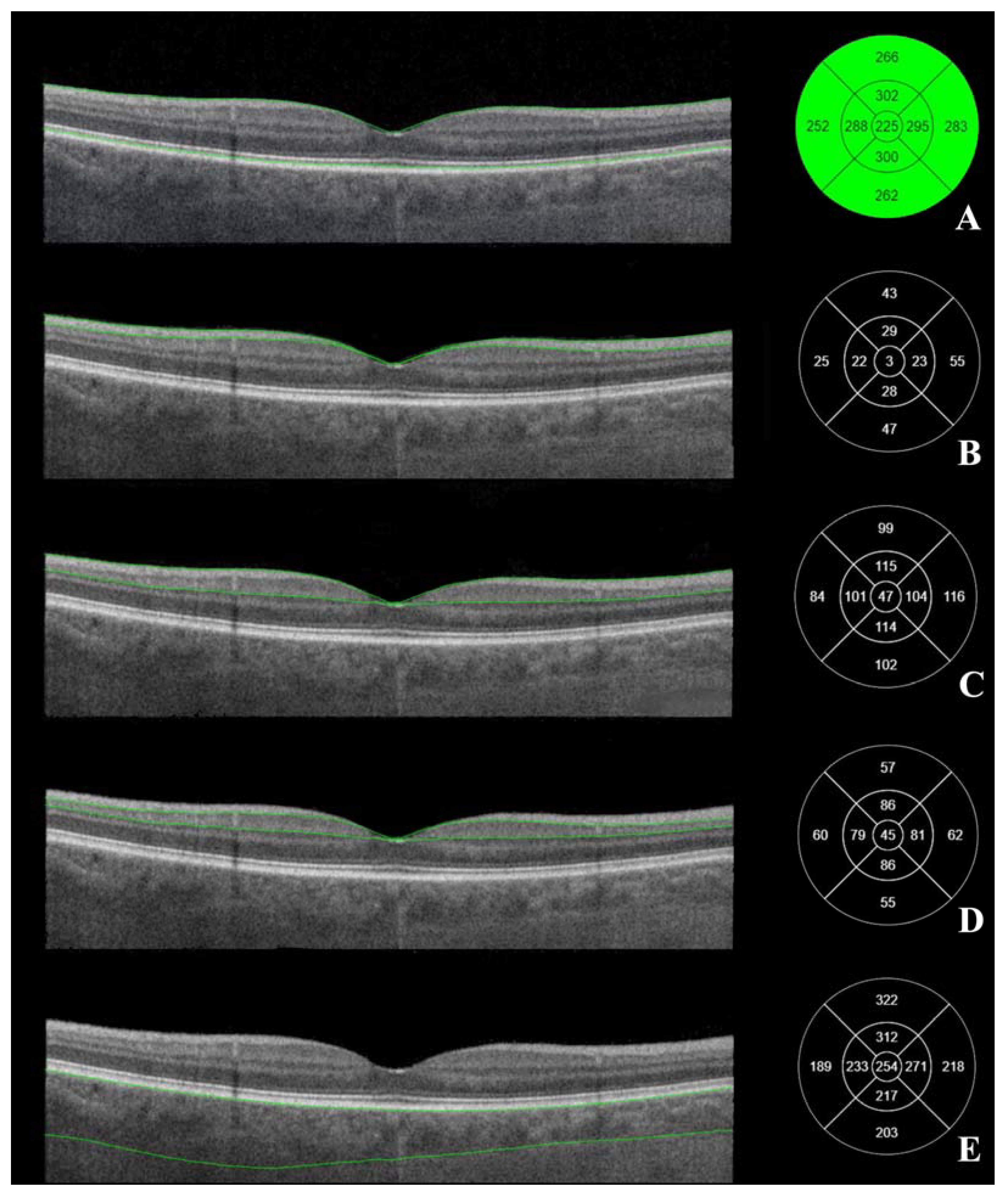
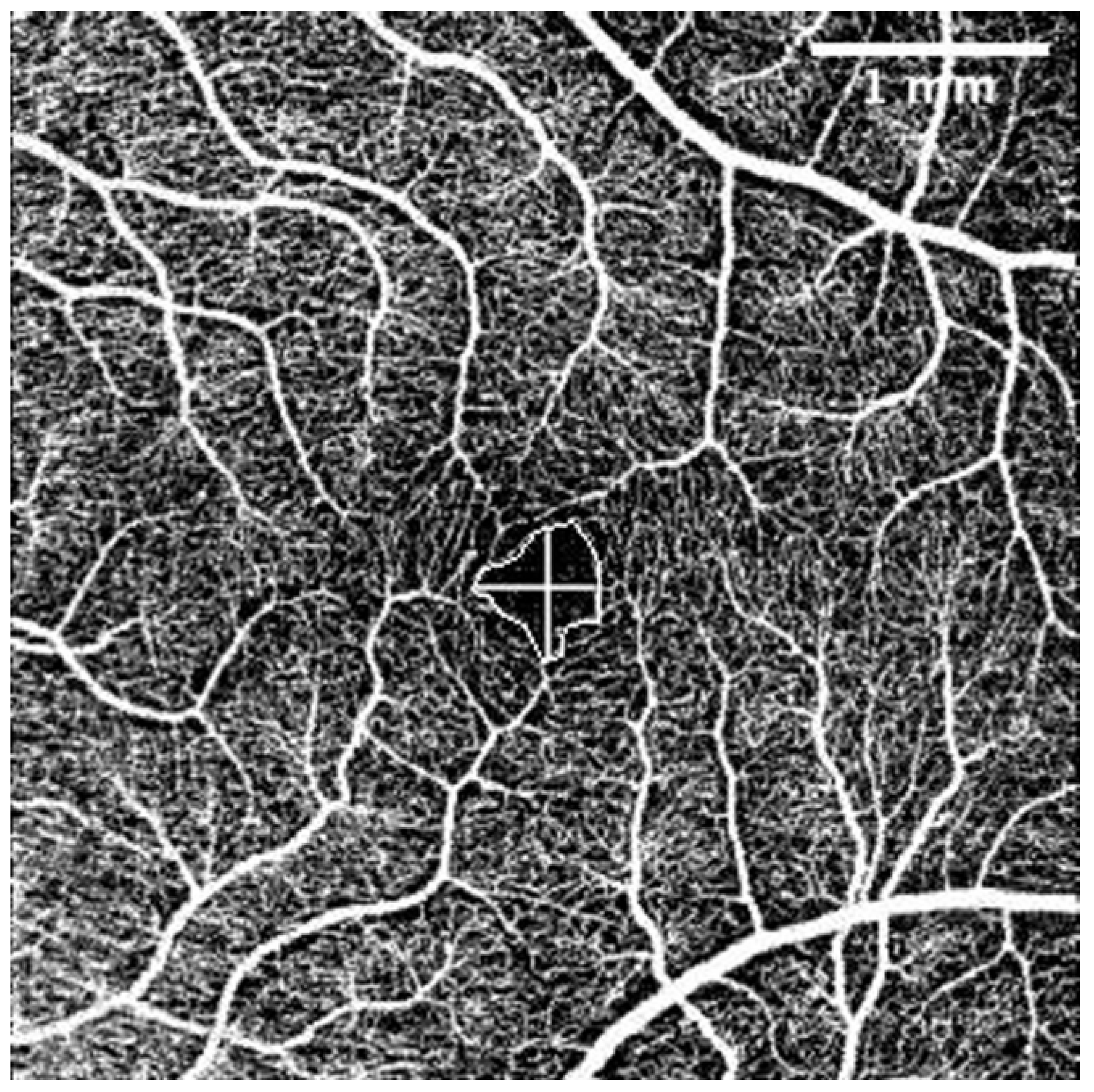
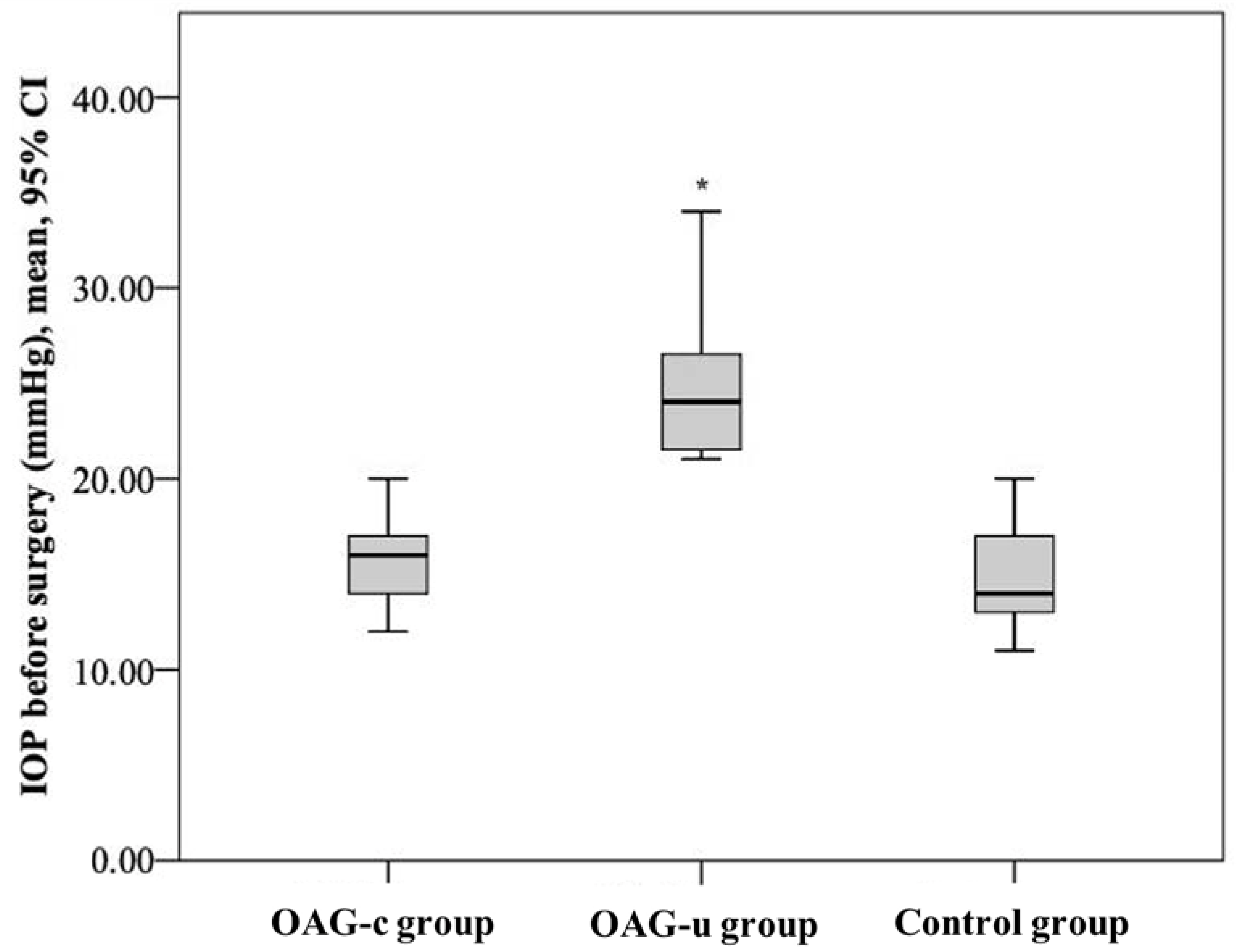
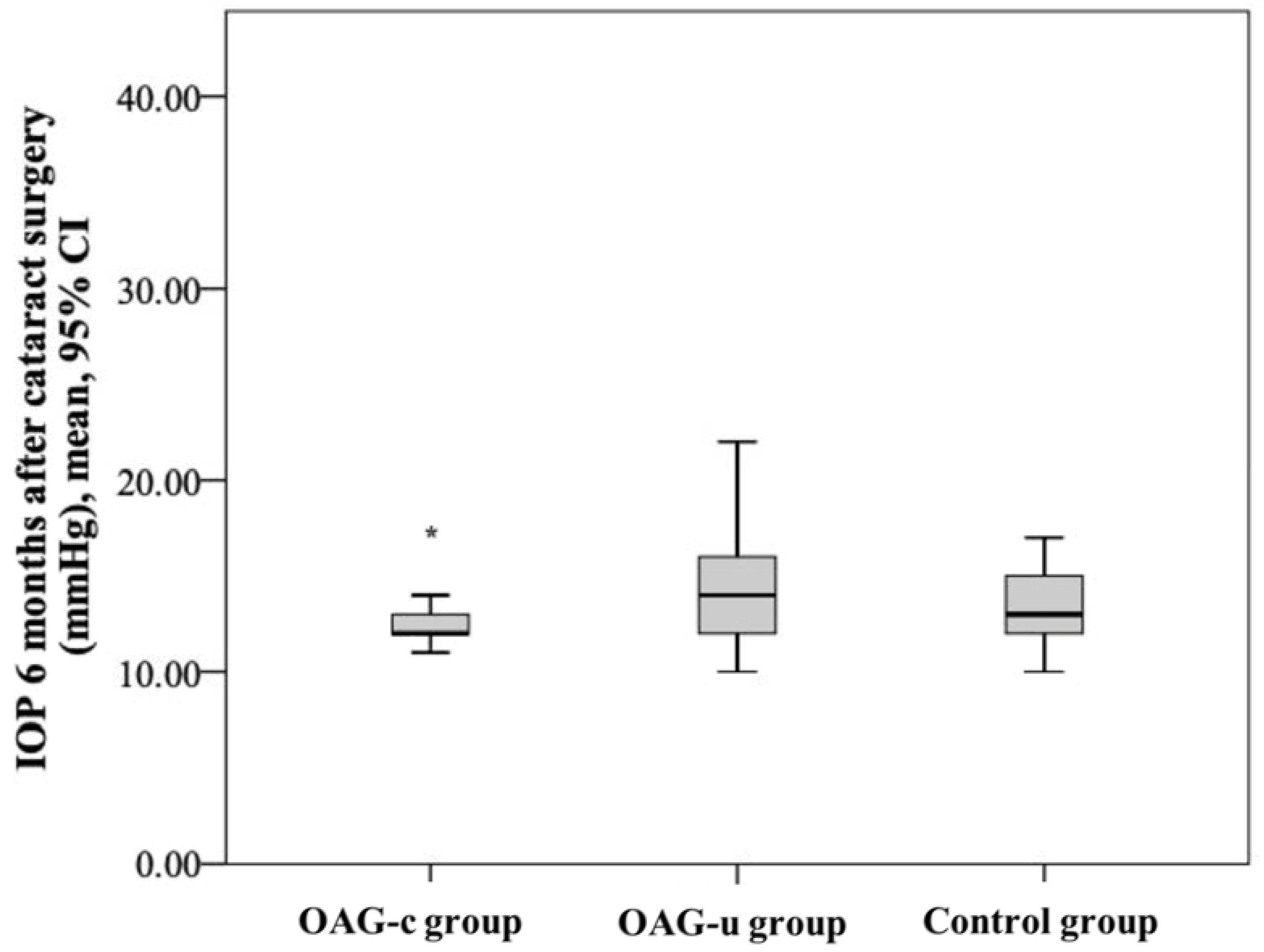
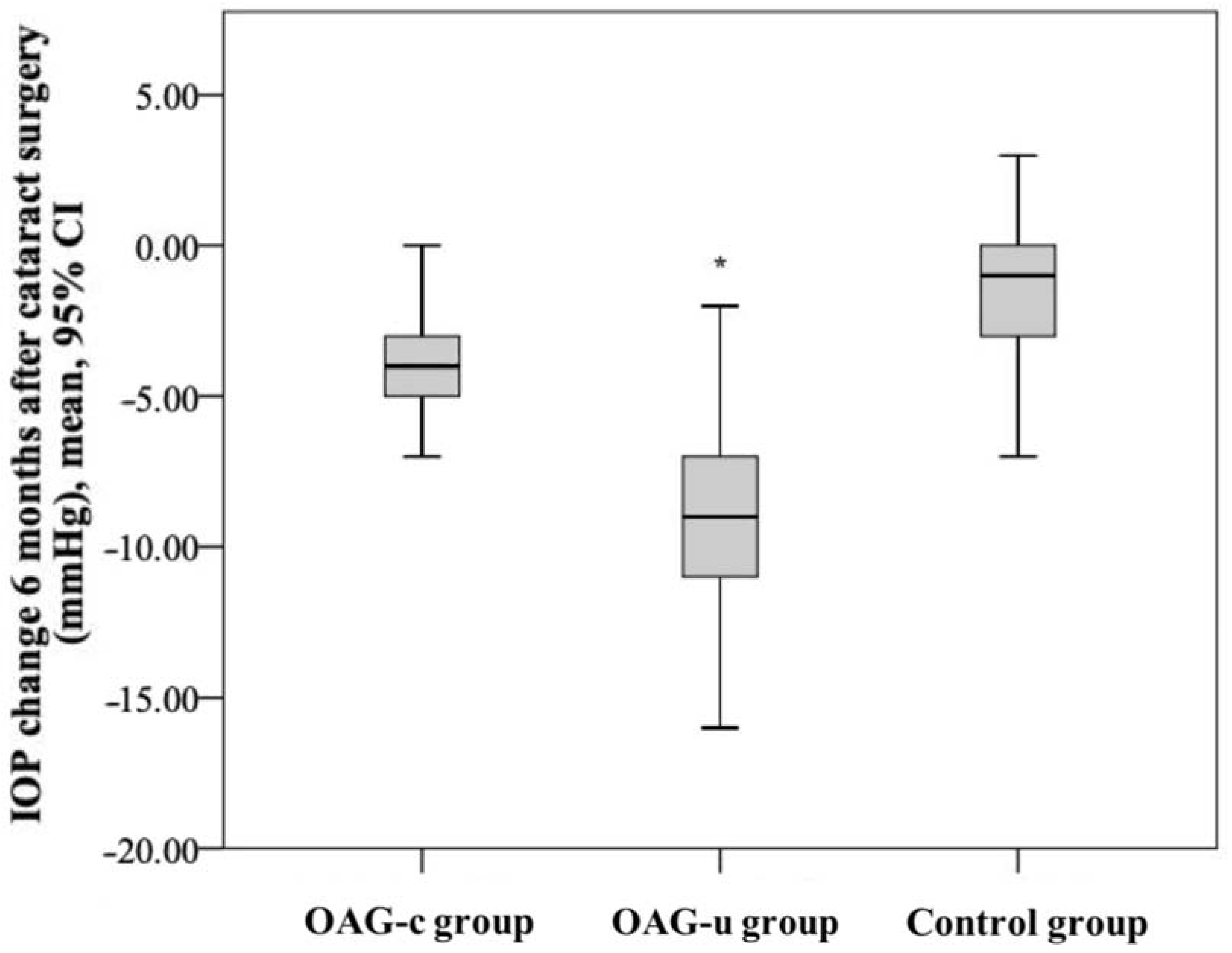
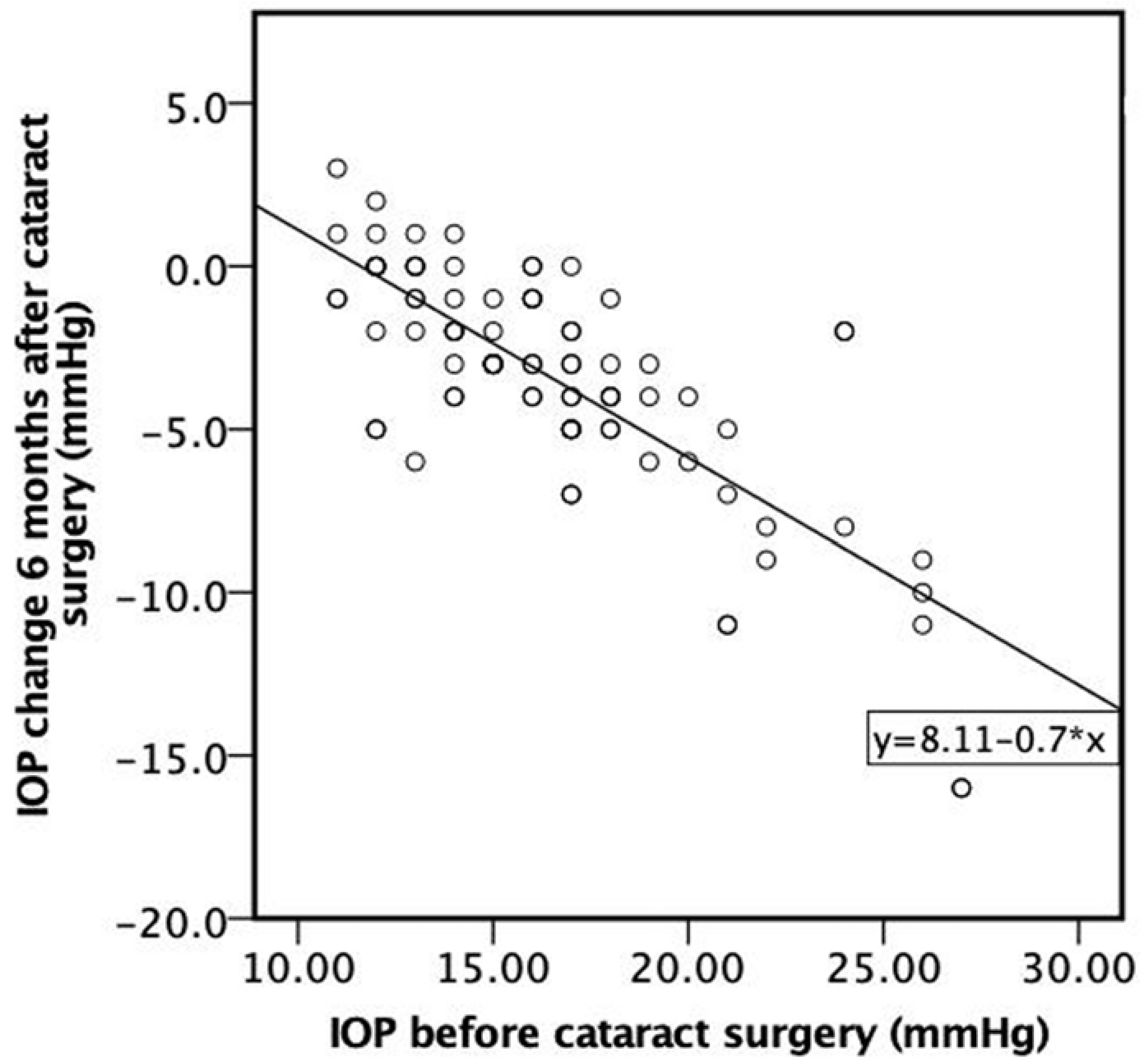
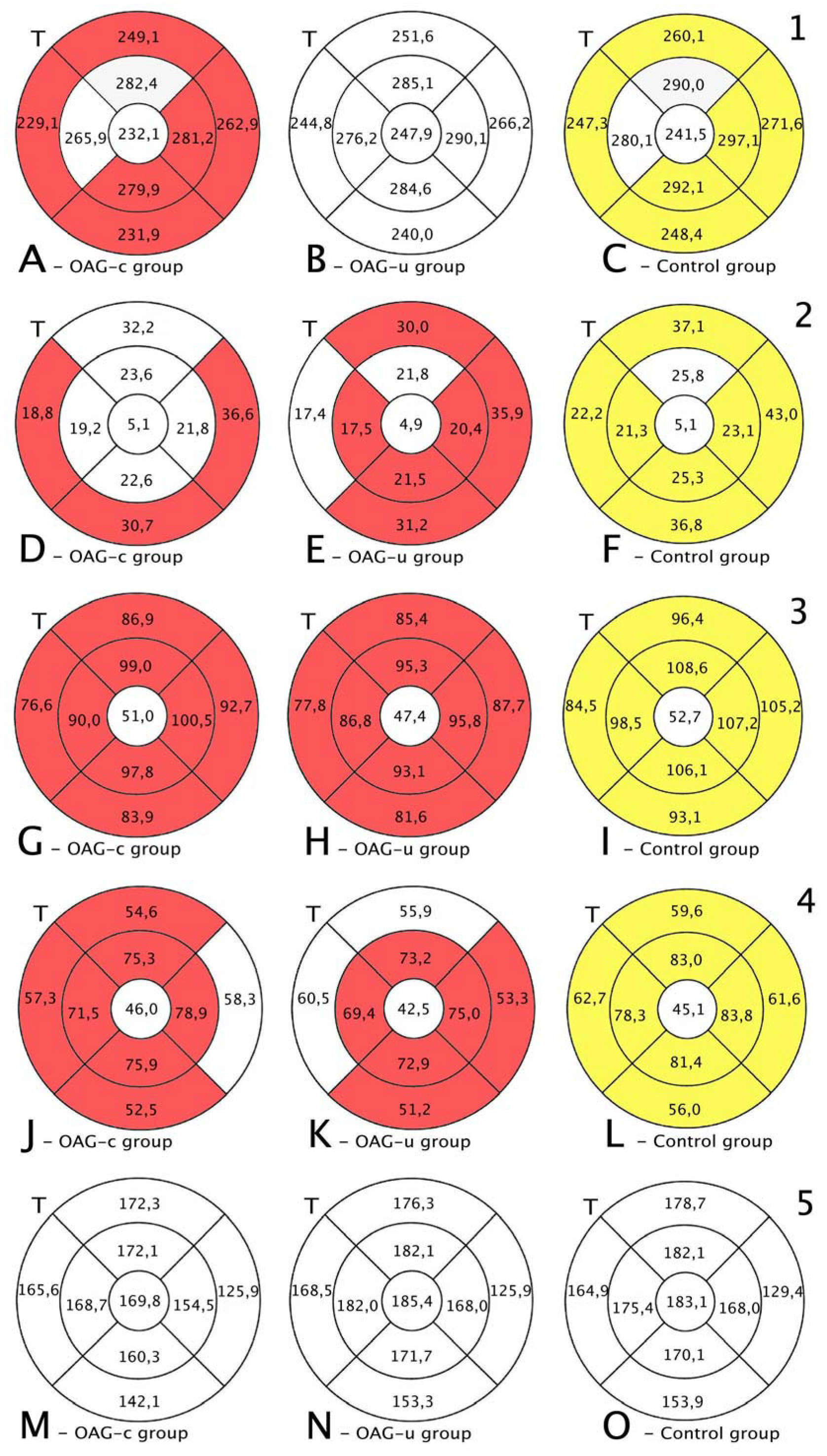
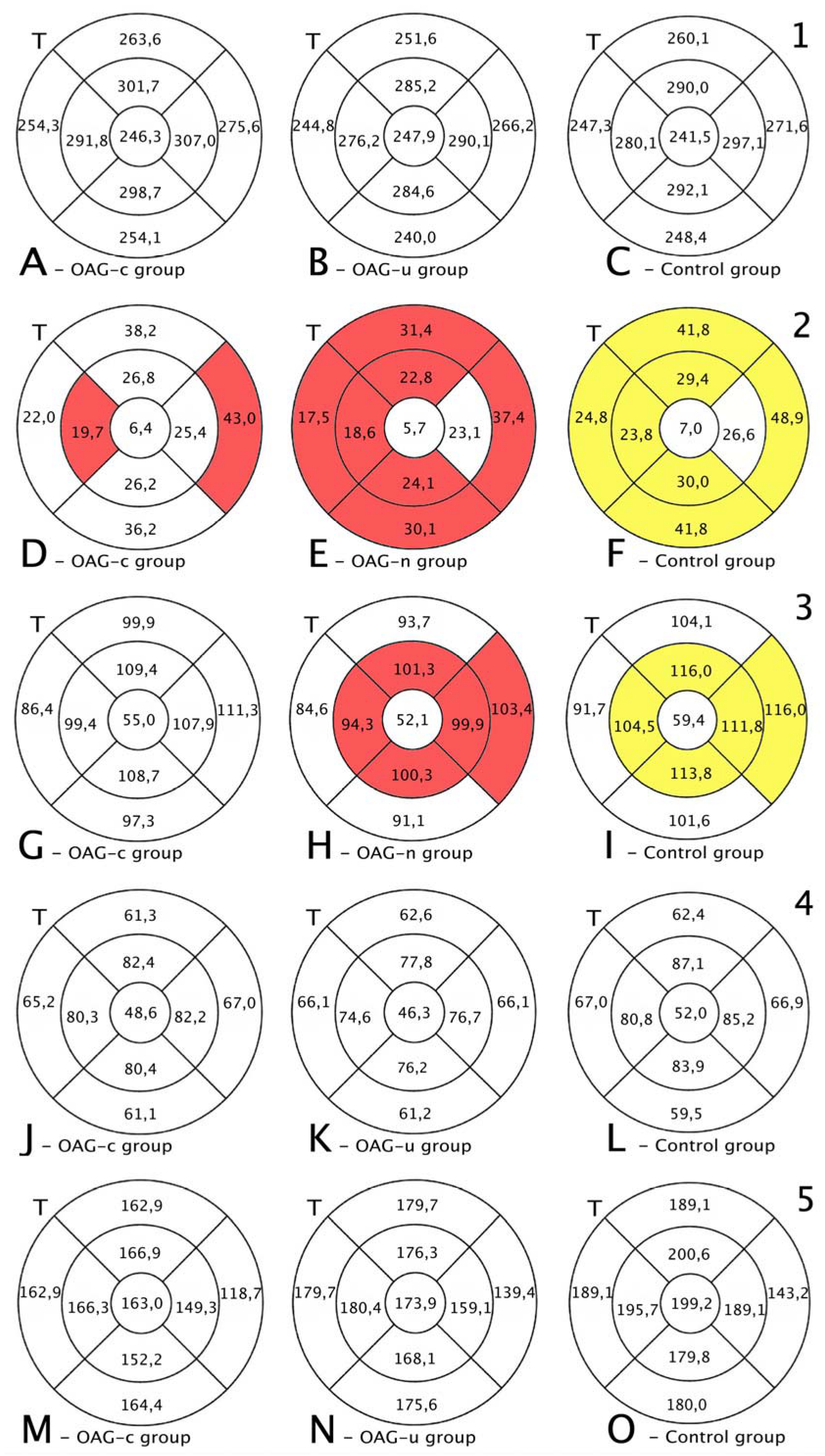
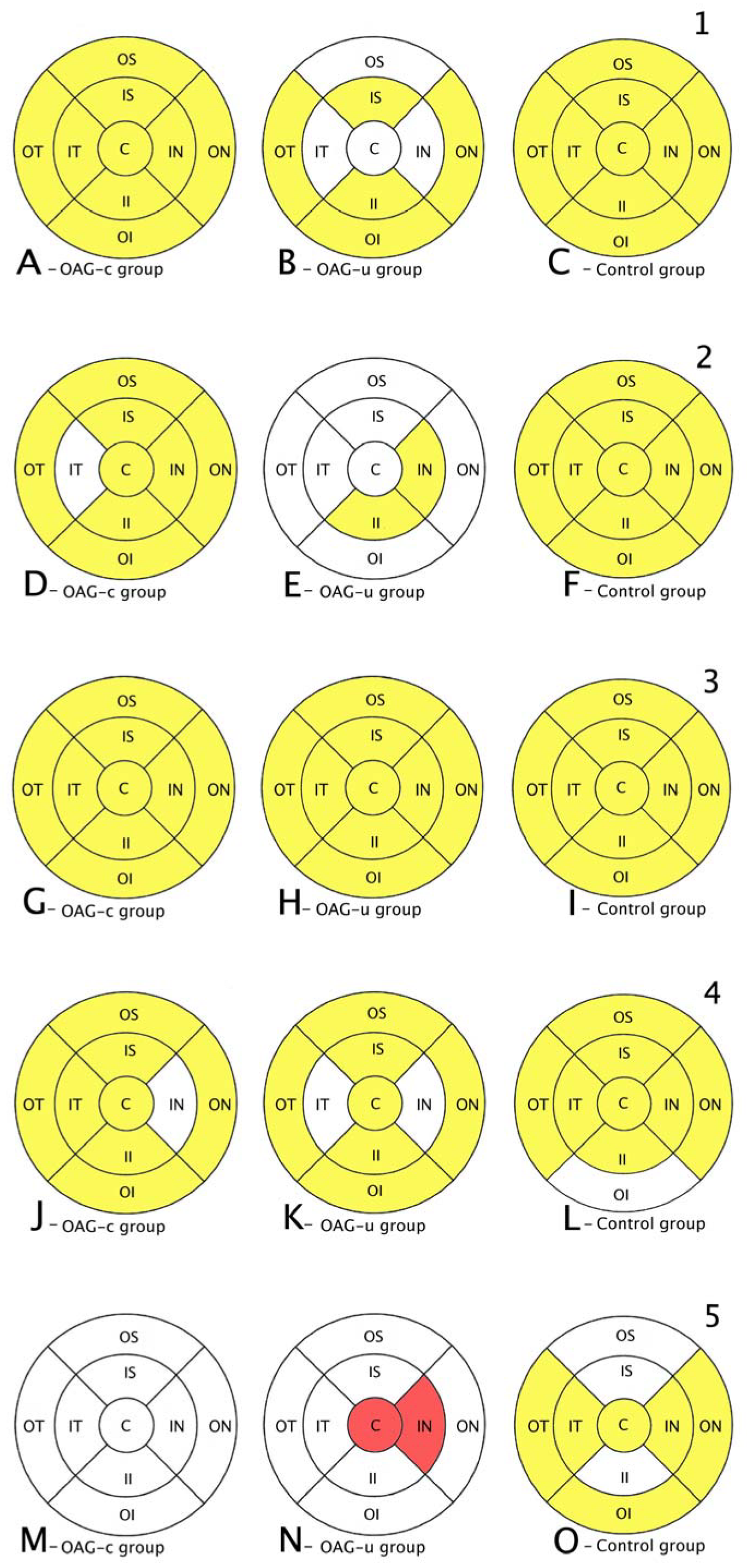
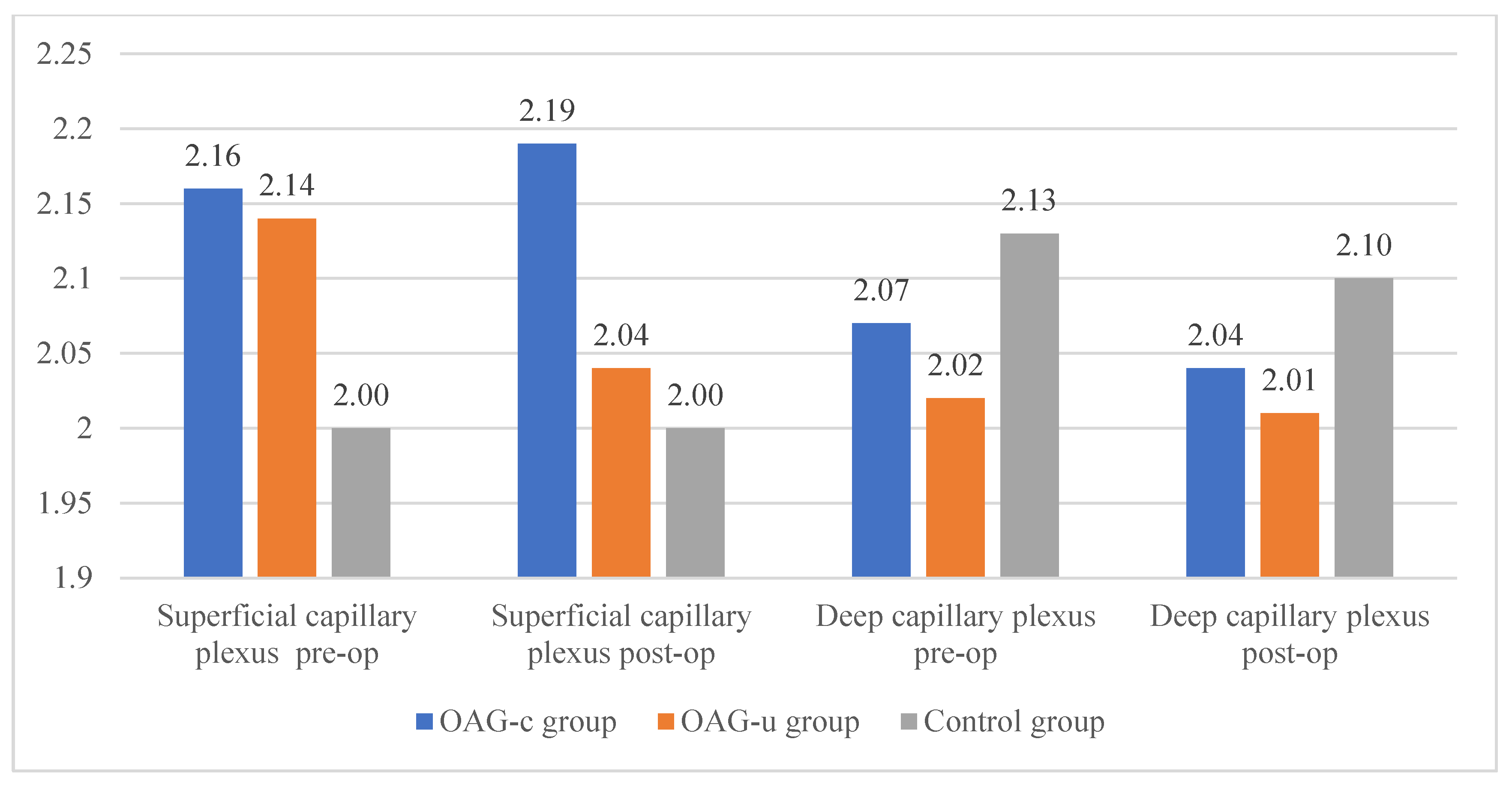
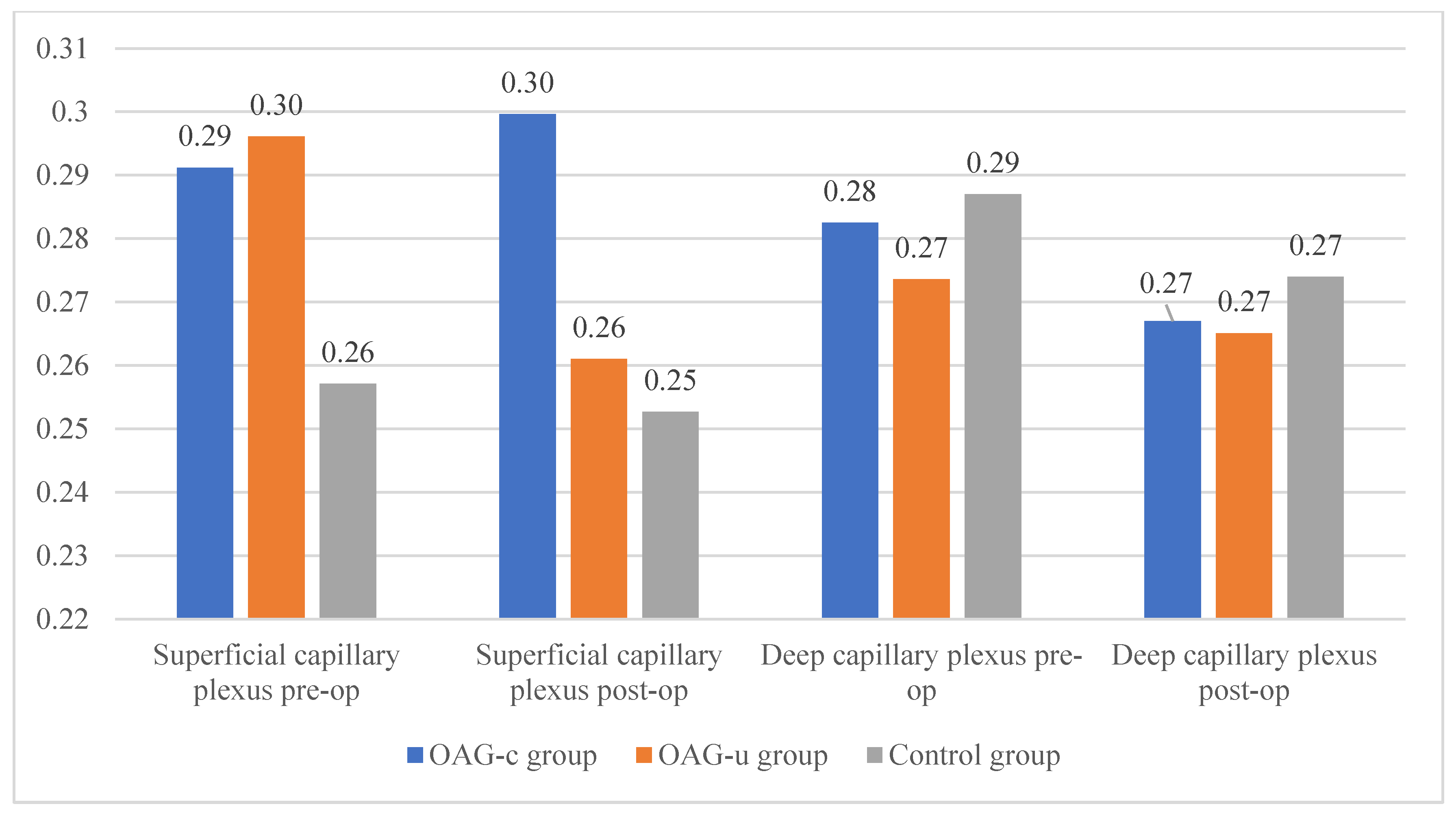
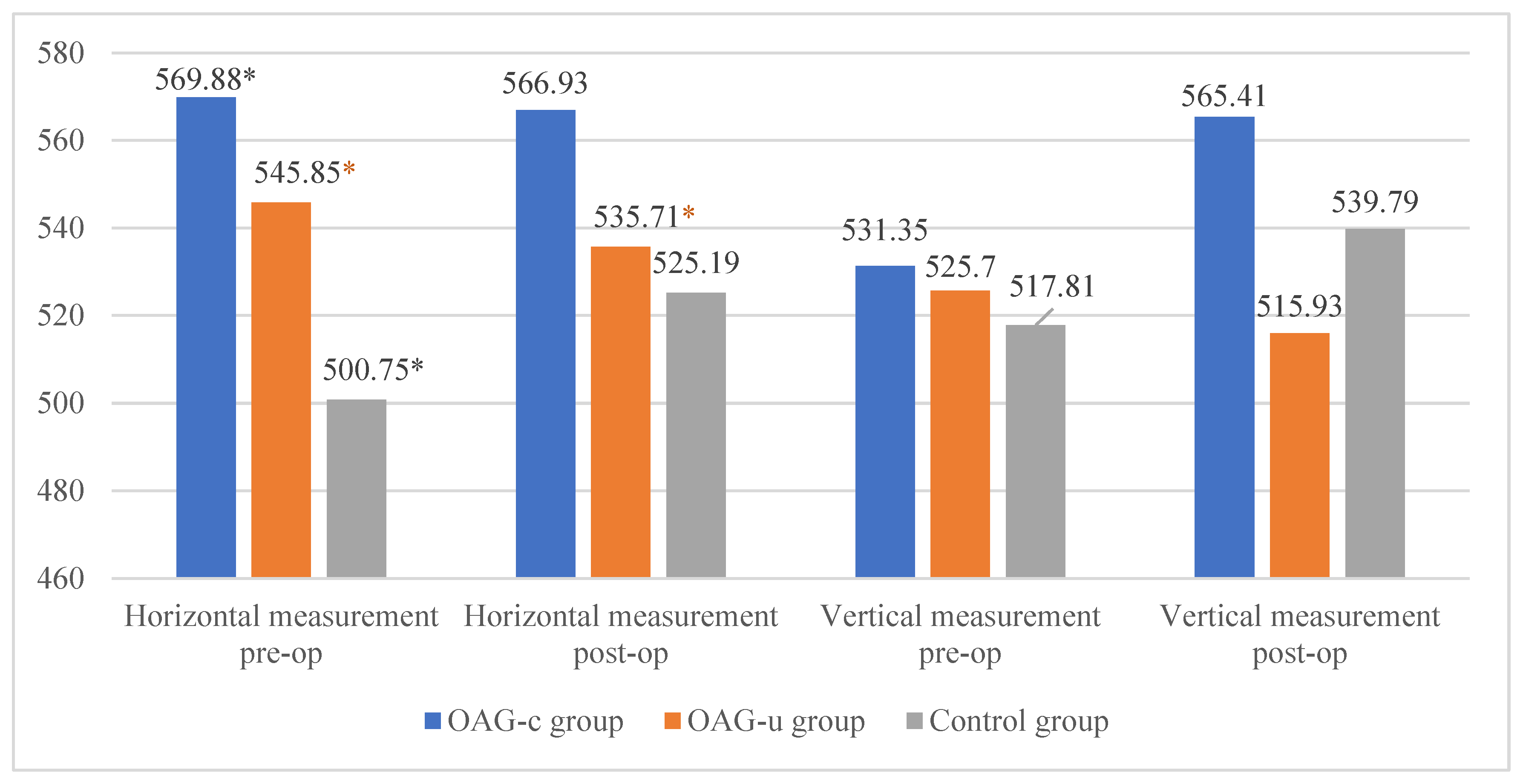

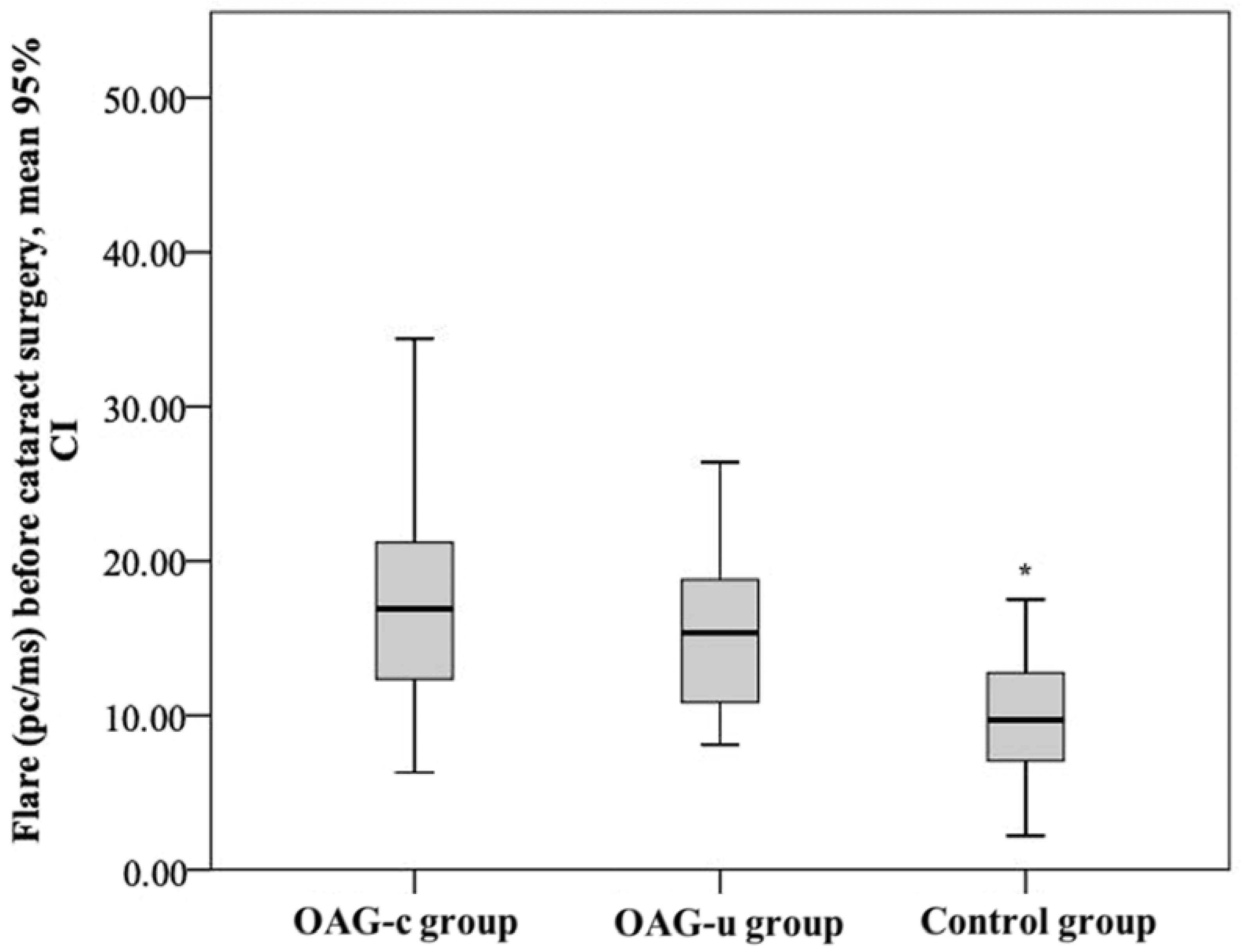

| Control Group (n = 60) | OAGc Group (n = 40) | OAGu Group (n = 20) | p | |
|---|---|---|---|---|
| Gender male (n, %) | n = 24, 40.0% | n = 16, 40.0% | n = 8, 40.0% | >0.05 |
| Age, mean (SD), min and max | 74.03 (6.4) (59–88) | 73.55 (6.6) (58–86) | 73.25 (6.9) (58–86) | >0.05 |
| Number of eyes | 60 | 40 | 20 | - |
| OAGc Group (n = 40) | OAGu Group (n = 20) | Control Group (n = 60) | p | |
|---|---|---|---|---|
| Antiglaucomatous compounds per day | * Χ2 = 25.69, df = 3, p < 0.001 | |||
| 0 | 0 | 0 | 60 | |
| 1 | 14 | 0 | 0 | |
| 2 | 17 | 3 | 0 | |
| 3 | 4 | 5 | 0 | |
| 4 | 5 | 12 | 0 | |
| Antiglaucomatous medication bottles per day | * Χ2 = 25.02, df = 2, p < 0.001 | |||
| 0 | 0 | 0 | 60 | |
| 1 | 28 | 2 | 0 | |
| 2 | 9 | 8 | 0 | |
| 3 | 3 | 10 | 0 | |
| Prostaglandin analogues (%) | 77.50% (n = 31) | 85.00% (n = 17) | 0% (n = 0) | * p = 0.734 |
| Beta blockers (%) | 70.00% (n = 28) | 100% (n = 20) | 0% (n = 0) | * p = 0.005 |
| Alfa-2 agonists (%) | 20.00% (n = 8) | 75% (n = 15) | 0% (n = 0) | * p < 0.001 |
| Carbonic anhydrase inhibitors (%) | 27.50% (n = 11) | 90.00% (n = 18) | 0% (n = 0) | * p < 0.001 |
| Artificial tears using ratio (%) | 35.00% (n = 14) | 35.00% (n = 7) | 16.60% (n = 10) | Χ2 = 5.263, df = 2, p = 0.081 |
| Total number of drops per day (SD) | 2.7 (1.7) | 4.7 (1.6) | 0.4 (0.8) | p < 0.001 |
| Group | IOP | Minimum Value | Maximum Value | Mean | SD |
|---|---|---|---|---|---|
| OAGc group | Before surgery | 12.0 | 20.0 | 15.8 | 2.1 |
| After surgery | 7.0 | 16.0 | 12.1 | 2.0 | |
| IOP change | −7.0 | 0 | −3.7 | 1.7 | |
| OAGu group | Before surgery | 21.0 | 28.0 | 24.4 | 3.3 |
| After surgery | 10.0 | 22.0 | 14.6 | 3.6 | |
| IOP change | −16.0 | −2.0 | −8.9 | 4.2 | |
| Control group | Before surgery | 11.0 | 20.0 | 14.9 | 2.4 |
| After surgery | 7.0 | 17.0 | 13.1 | 2.0 | |
| IOP change | −7.0 | 3.0 | −1.5 | 2.1 |
Disclaimer/Publisher’s Note: The statements, opinions and data contained in all publications are solely those of the individual author(s) and contributor(s) and not of MDPI and/or the editor(s). MDPI and/or the editor(s) disclaim responsibility for any injury to people or property resulting from any ideas, methods, instructions or products referred to in the content. |
© 2023 by the authors. Licensee MDPI, Basel, Switzerland. This article is an open access article distributed under the terms and conditions of the Creative Commons Attribution (CC BY) license (https://creativecommons.org/licenses/by/4.0/).
Share and Cite
Pakuliene, G.; Rylskyte, N.; Kuzmiene, L.; Siesky, B.; Verticchio, A.; Harris, A.; Januleviciene, I. Changes in Macular Thickness after Cataract Surgery in Patients with Open Angle Glaucoma. Diagnostics 2023, 13, 244. https://doi.org/10.3390/diagnostics13020244
Pakuliene G, Rylskyte N, Kuzmiene L, Siesky B, Verticchio A, Harris A, Januleviciene I. Changes in Macular Thickness after Cataract Surgery in Patients with Open Angle Glaucoma. Diagnostics. 2023; 13(2):244. https://doi.org/10.3390/diagnostics13020244
Chicago/Turabian StylePakuliene, Giedre, Neda Rylskyte, Loreta Kuzmiene, Brent Siesky, Alice Verticchio, Alon Harris, and Ingrida Januleviciene. 2023. "Changes in Macular Thickness after Cataract Surgery in Patients with Open Angle Glaucoma" Diagnostics 13, no. 2: 244. https://doi.org/10.3390/diagnostics13020244
APA StylePakuliene, G., Rylskyte, N., Kuzmiene, L., Siesky, B., Verticchio, A., Harris, A., & Januleviciene, I. (2023). Changes in Macular Thickness after Cataract Surgery in Patients with Open Angle Glaucoma. Diagnostics, 13(2), 244. https://doi.org/10.3390/diagnostics13020244








